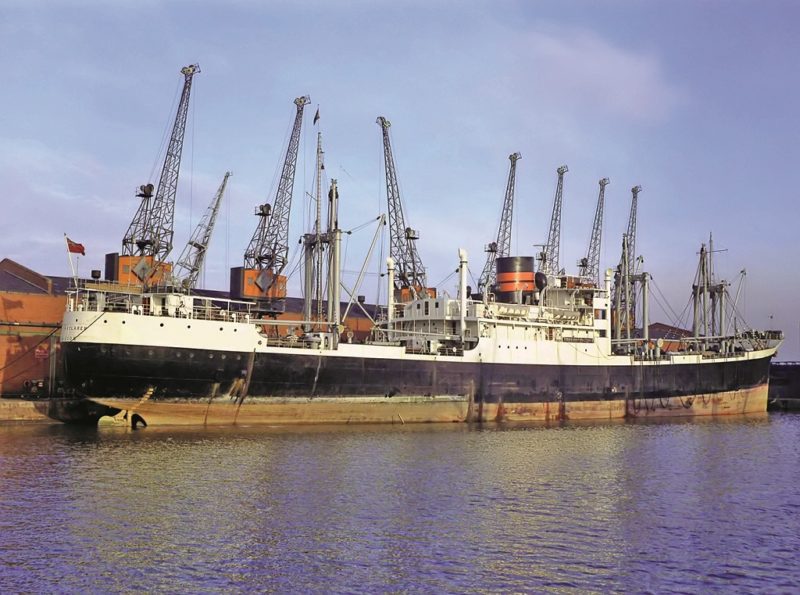
Clan Line suffered the loss of thirty ships to enemy action and marine causes during World War II. The granting of independence to India in 1947 badly affected the fortunes of Clan Line and many other British liner companies that traded extensively to the sub-continent, and other trades were expanded with greater numbers of voyages to South Africa and East Africa to partly replace the Indian trades. The Australian trade was gradually decreasing, and Clan Line and the Scottish Shire Line provided in 1950 fifteen homeward sailings from Australia, but this dropped to eleven sailings homeward in 1953 and only eight in 1957, six sailings in 1960, five sailings in 1961, six sailings in 1965, and only three in 1969 when new container ships displaced all B & C Group cargo-liners trading to Australia.
Phase 1 of the rebuilding of the fleet was completed by the purchase of nine ‘Empire’, nine ‘Ocean’, and two ‘Liberty’ war standard ships. Sadly, Clan Keith built as Ocean Verity in California in 1942, broke in two on 5th November 1961 when eleven miles south of Galita Island off the coast of Tunisia after striking the Ecueils des Sorelles Rocks near Cape Bon while on a voyage from the U.K. to Colombo via Malta with general cargo in heavy seas. The after part sank later the same day and the forward section sank the following morning. There were only six survivors from a crew of 68, five of whom were picked up by the British tramp Durham Trader of 6,214 grt and built in 1959 for Trader Navigation Co. Ltd.
A large building programme of steam and diesel powered cargo-liners was then embarked upon in 1946, starting with the six ships of the ‘Clan Macl’ class of 8,800 dwt with dimensions of overall length of 445.0 feet, moulded beam of 61.0 feet and a loaded draft of 26.0 feet. Two of the class, Clan Maclennan and Clan Maclachlan, had steam turbines while the remainder were equipped with diesel engines. They were distinguished by three sets of kingposts, each with one heavy and smaller capacity derricks. Two single posts stood immediately in front of the bridge and behind the superstructure. Topmasts were carried on the first pair of kingposts and on the pair aft of the superstructure. Clan Maclaren, Clan Maclean, Clan Macleod and Clan Maclay with six cylinder diesel engines were to give considerably longer service to Clan Line than the two steamers of the class, which were all completed by the Greenock Dockyard.
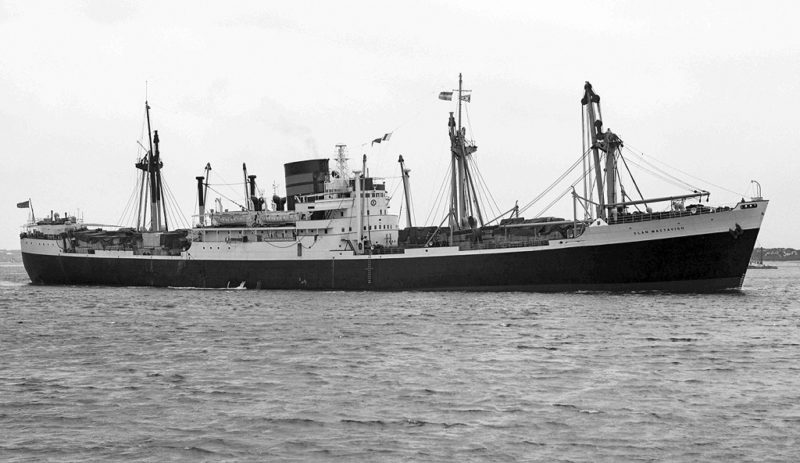
In 1948, Clan Line re-entered the passenger trade, with fourteen of their ships offering accommodation for a dozen First Class passengers and the accommodation was always well patronised. Two turbine powered sisters of 8,035 grt, Clan Mactavish and Clan Mactaggart, were then completed in 1949 by the Greenock Dockyard. A heavy lift derrick of 125 tons capacity, the heaviest ever fitted to a Clan Line vessel at this time, was carried on the foremast of three masts with a topmast on the second and the one aft. A lattice navigation mast of pyramid shape stood on the monkey island above the bridge. They had pole main and mizzen masts rather than kingposts. At this time, the white upper parts of the hull including the bulwarks extended three feet down the hull, with this pair being the first to have this feature to give an enhanced appearance. Clan Mactavish sailed from the Tees in April 1962 to Australia with two complete Linz & Donowitz furnaces weighing in at 1,300 tons and reduced to manageable lifts when broken down into sections. The destination was Newcastle (NSW) and the Broken Hill Proprietary (BHP) Co. Ltd. The movement of some of the 2,993 tons of water ballast in the double bottom, port and starboard tunnel and deep tanks allowed the stability of this pair to be maintained during heavy lifts.
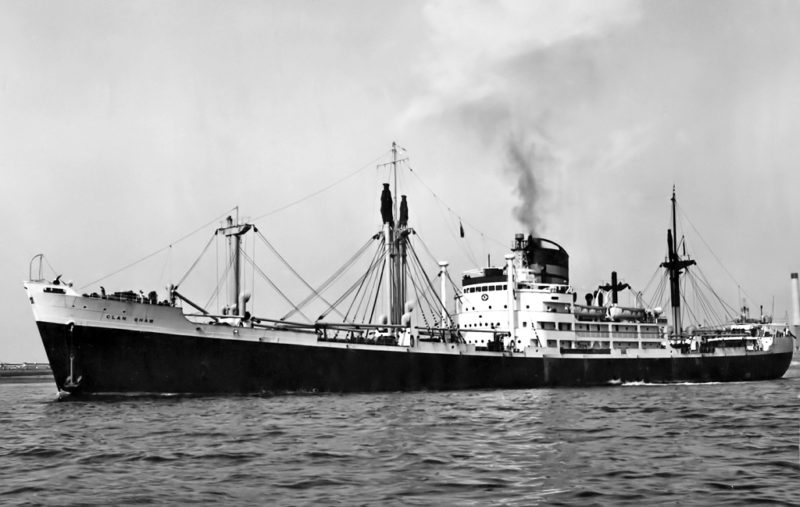
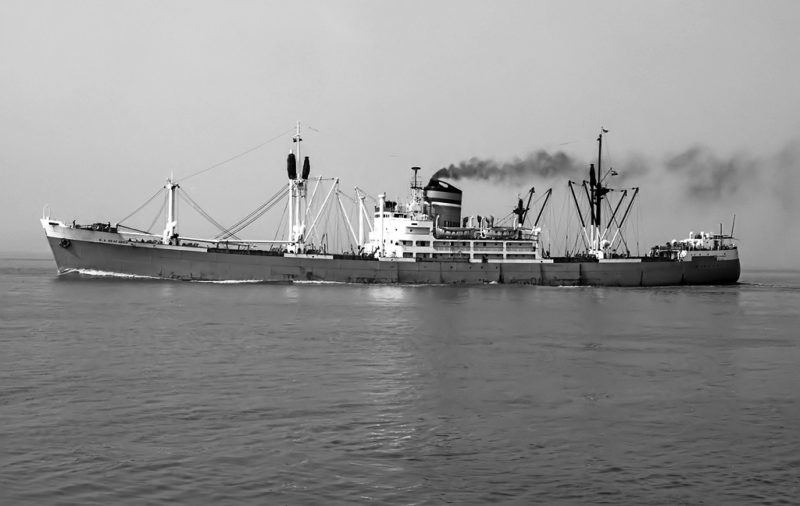
CLAN LINE ‘S’ CLASS of the 1950s
Phase 2 of the rebuilding began with Clan Shaw of the ‘S’ class when she was launched on 23rd August 1949 by Lady Rotherwick at Greenock for the South Africa, East Africa and Round Africa services. She had five holds, and was of mixed riveted and welded construction, 8,101 grt and 11,000 dwt, carried on two continuous decks below the weather deck and the lower holds and split by eight transverse bulkheads to give fifteen cargo spaces.
She had a cruiser spoon stern and a broad funnel with a very distinctive cowl on top. The funnel was known as the ‘Helmet’ and ensured efficient smoke dispersal away from the passenger accommodation. It also disguised the extra height of the funnel whilst showing off the company colours to the best advantage.
The accommodation was well finished for twelve passengers, raising the superstructure by one deck with two double and eight single staterooms all equal in comfort to passenger liners of this time with bathroom and toilet en-suite.
Clan Shaw had hull dimensions of overall length 512.0 feet, moulded beam of 66.0 feet and a loaded draft of 27.0 feet, with cargo gear in abundance consisting of a 60 ton heavy lift and a 30 ton heavy lift on the second mast, with another 30 ton derrick on the mast aft, plus two 15 ton, two 7 ton and twelve 5 ton derricks, worked by electric cargo winches.
The weather deck covers were a mixture of hatch board and beams. Later ships had slab covers, particularly if the vessel was trading to Australia where this was compulsory.
There was also wooden panelling on the front of the monkey island above the bridge. Babcock & Wilcox boilers and the well tried Wallsend-Howden oil burners and Parsons geared turbines gave 10,000 shp and a service speed of 17 knots.
Clan Shaw made her maiden voyage to South Africa on 25th January 1950 under the command of Capt. R.P. Galer CBE. In 1953, she represented the company at the Coronation Review at Spithead and was commanded on this occasion by Capt. H.J. Anchor OBE, who was invited for presentation to H.M. The Queen on board HMS Surprise. The number four ‘tween deck was converted into a carpeted overflow lounge to cope with the large number of company guests aboard.
In 1955, talks began with the Board of the Union-Castle Line and a year later Clan Line Steamers Ltd. merged with Union-Castle Line to form the British & Commonwealth Shipping Company, a £53 million merger.
Lord Rotherwick had achieved this after many years of competition on the South African route, and he served as the first B. & C. Chairman until his death in 1958. He was succeeded by his nephew Sir Nicholas Cayzer, elder son of Sir August Cayzer. Among the UCL subsidiaries taken over was the long established Bullard, King Line whose ships had names beginning ‘Um’ and whose sailing rights and equity were transferred to a new company, Springbok Line of South Africa in 1959. This was a paper transaction involving the exchange of shares, and was a precautionary measure taken in case flag discrimination was practised against British ships. The 1956 merger of Clan Line and UCL created one of the eight largest liner groups in the U.K., which between them owned well over 80% of all British liner tonnage as well as some tramp and tanker tonnage.
Clan Shaw was transferred to this company in 1960, becoming Steenbok and in the following year to South African Seafarer after a full merger had taken place between Springbok Line and Safmarine. She was renamed S.A. Seafarer in 1966, but on approaching Cape Town in darkness and heavy seas on 1st July 1966 she ran aground off the Green Point Light outside Cape Town harbour while inward bound from Glasgow with 63 crew and a dozen passengers including a six month old baby. All were rescued at daybreak by helicopter, the ship having earlier broken her back. The cargo consisted of 7,000 tons of chemicals and thousands of bottles of whisky and drifted ashore for many weeks after the stranding. The wreck was broken up by a local scrap metal company after becoming unrecognisable as a ship. The Master had his certificate suspended for two years at the subsequent enquiry.
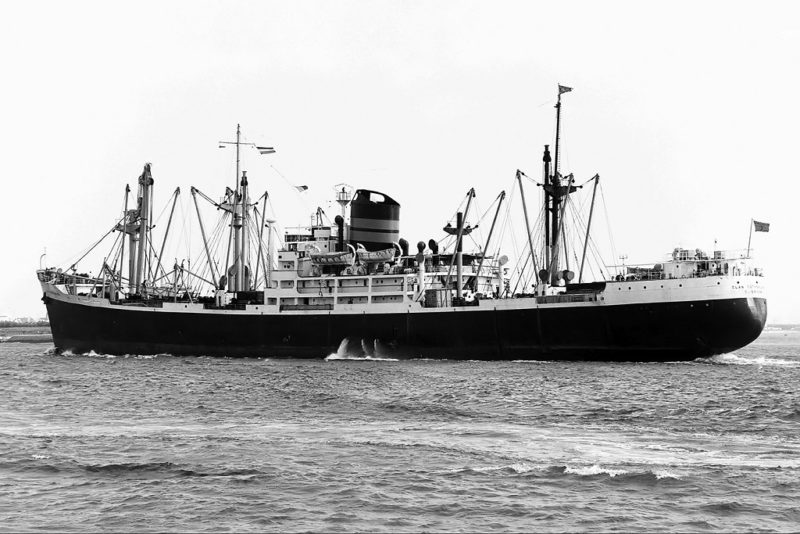
Clan Sinclair was launched next on 17th January 1950 at Greenock and made her maiden voyage in April 1950. She was a regular caller at Mauritius to load bagged sugar at anchor from barges. She followed the same pattern of renamings as her sister, becoming Bosbok in 1960, South African Statesman in 1961, S.A. Statesman in 1966 and arrived at Kaohsiung on 3rd November 1972 for breaking up.
Clan Sutherland was launched on 28th December 1950, the ceremony being performed by the Duchess of Sutherland of Dunrobin Castle to the north of Dornoch Firth. Successful trials were held in the Clyde on 30th March 1951 and she left Birkenhead on 28th April 1961 for South Africa under the command of Capt. H.J. Anchor OBE. She discharged and loaded at Beira and came home via Suez. In December 1960, her original 65 ton derrick was replaced by the largest heavy lift gear in the Clan Line fleet. This 180 ton derrick with a SWL of 165 tons on the short masts between numbers 1 and 2 holds was the principal reason why she was retained by the company long after her sisters had been sold off. The mast was heavily stayed by steel rods connecting the top of the mast to strongpoints on the steel deck, and at least six Clarke Chapman of Gateshead winches were needed to operate the massive derrick. It was tested with a load of 181.5 tons with the ship ballasted down with water and fuel oil to give an angle of heel of only 8.5 degrees. The total weight of the derrick and winches was 205 tons, and she was also able to load cargo on number 2 hatch as the deck was clear of obstruction.
Movement of some of her 2,679 tons of water ballast in the double bottom, port and starboard tunnel and deep tanks was necessary to the tanks on the opposite side of the ship from where the lift on the quay was being performed. Some examples of heavy lifts performed by Clan Sutherland were as follows:-
- A 162 ton stator taken from Birkenhead to South Africa in 1964
- A paper mill cylinder weighing over 100 tons for Transvaal in 1966
- A 148 ton transformer taken from Genoa to Port Elizabeth in January 1969
- Heavy lifts to Australia on several occasions from November 1952 including a 152 ton stator for
- Sydney, a 162 ton stator for Melbourne, and a 91 ton turbo-alternator for Fremantle.
The freight charges for heavy lifts normally paid for the expenses of the whole return voyage, and the other cargo charges meant profit all the way.
Clan Sutherland was involved in a bad fire at Beira in 1954, when an oil leak from an upriver berth ignited between herself and the quay. The ship was working cargo at the time and there was some loss of life among local dockers as well as the ship’s doctor, who suffocated down a hold when thick smoke engulfed them, Capt. A.G. Storkey was later awarded the OBE for his actions on that occasion. The fire had occurred only one week after she was in collision with the Italian ship Rinano as she entered Beira. She served Clan Line very well for over twenty years before she was sold to the Chinese Government in 1971 and traded for a number of years as Zhan Dou 3 before breaking up took place.
Two sisters of the Clan Line ‘S’ class were completed for the Pacific Steam Navigation Company (PSNC) as Kenuta and Flamenco, the five ship order for yard numbers 471 to 475 from the Greenock Dockyard being changed with the sale of yard numbers 473 and 474. PSNC subsequently built three more identical sisters to the ‘S’ class in Cotopaxi from the Denny yard at Dumbarton, Potosi and Pizarro from Greenock Dockyard, the only minor difference being the installation of mechanical hold ventilation.
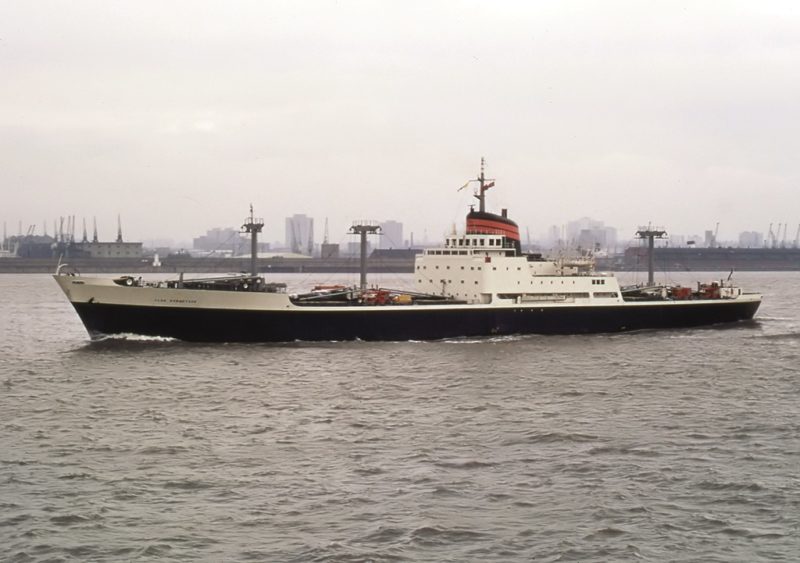
In 1950, Clan Line were operating a fleet of four dozen steamers and motor ships, none of which was more than twenty years old. In 1951/52, three smaller motorships of 9,000 dwt were completed as Clan Macinnes, Clan Macintosh and Clan Macintyre, the last pair by the yard of John Brown at Clydebank. They had two low crosstree masts to serve the forward holds and one aft, while two more pairs of derricks stood on posts immediately in front of the bridge and behind the superstructure.
These motorships also lasted longer in service than the steamers. Clan Macintyre came to grief under the name of Eastern Express when she grounded to the south of La Spezia at Marina di Carrara, the famous white marble mine area, as she left port for Sardinia and she was declared a total loss.
The Thompson Steam Shipping Co. Ltd. was acquired in 1952, together with three standard World War II types in Amersham ex Empire Envoy, Cheltenham ex Empire Rain and Farningham ex Ocean Vestal. Farningham was transferred to the Houston Line and renamed Hellenes and subsequently in 1957 registered under Clan Line Steamers Ltd., and the other pair were sold off.
The management of three tankers of the Scottish Tanker Company, a Cayzer Irvine company, was transferred to the Thompson management company of Huntley, Cook Ltd.
Clan Campbell of 1943 loaded an unusual cargo after two pontoon barges had been chopped in half, each of the four halves being of dimensions 50 feet by 40 feet by 6.5 feet, in May 1953 at Swansea for Aden, discharging them using her own gear for use as the base of a 100 ton floating crane. A special short lifting beam had to be designed for these lifts of 65 tons each so that Clan Campbell could use her 80 ton heavy lift derrick and not foul the headroom restrictions of the ship. The second twin half barges were lifted onboard Clan Lamont on 3rd June 1953 at Swansea, one half on top of the other on number two hatch.
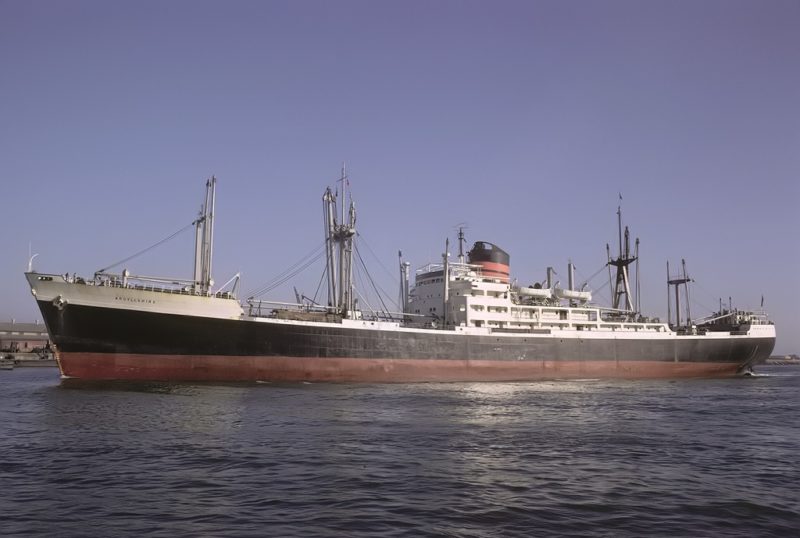
Clan Stewart was launched on 22nd October 1953 by Hon. Mrs Robin Cayzer, trials were run on 22nd January 1954 and she sailed on her maiden voyage to South Africa on 17th March 1954 again under the command of Capt. H.J. Anchor OBE. In 1961, she was transferred to Safmarine and renamed South African Sculptor. However, she was transferred back to B. & C. in the following year and renamed Kinpurnie Castle, sailing with Clan Line officers and a Zulu crew.
She and Clan Sutherland also acted as B. & C. cadet ships with a dozen cadets being given their first trip at sea on each voyage. Clan Sutherland made her first cadet voyage to Australia leaving the U.K. at the end of September 1964. Kinpurnie Castle just managed to sail from Port Said and Alexandria before the Suez Canal was closed by the Arab-Israeli War and later that year she was sold off to flag of convenience owners and renamed Hellenic Med. She arrived at Gadani Beach on 15th March 1978 for breaking up.
Clan Robertson and Clan Ross followed in 1954/55 from Greenock Dockyard with longer 174 feet bridge structures but similar dimensions and cubic capacity to the ‘S’ class.
They were considered by many people to be the most handsome Clan Line ships of the post-war period. They had a 105 ton heavy lift derrick and a very full complement of 40, 15, 7 and 5 ton derricks, with a pair of posts instead of a single mast at number 4 hold as in the ‘S’ class.
Clan Robertson was launched on 17th March 1954 by Hon. Mrs Anthony Cayzer and sailed for South Africa in June of that year on her maiden voyage. She loaded many export cargoes at Birkenhead for South Africa, and was transferred to Bullard, King Line in 1959 and renamed Umzinto. In 1960 she was transferred to Springbok Line and renamed Rooibok, and in 1961 to Safmarine and renamed South African Shipper, becoming S.A. Shipper in 1966. She arrived for breaking up at Kaohsiung on 26th November 1975.
Clan Ross was launched on 17th January 1955 by Miss Nichola Cayzer and sailed on Clan Line South African voyages for six years until transferred to Safmarine in 1961 and renamed South African Scientist.
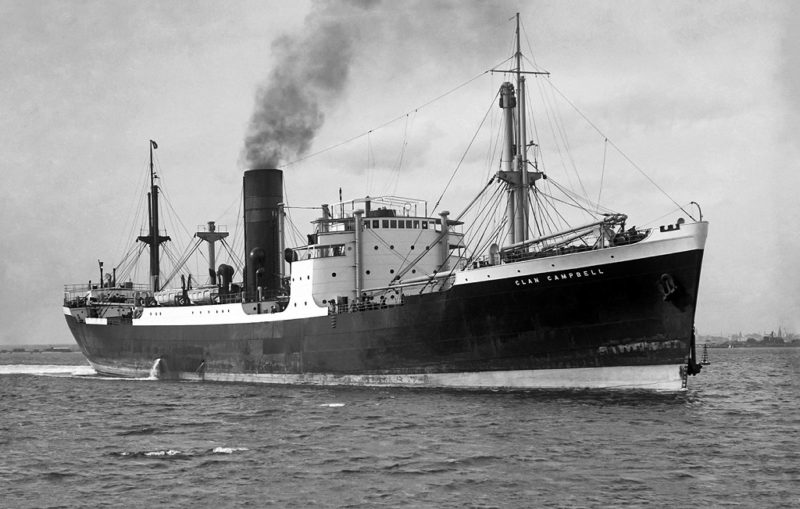
However, she was transferred back again in 1962 and renamed Kinnaird Castle and sailed with Clan Line officers and a Zulu crew. She made a round voyage to Australia in late 1967 to the Spring of 1968, sailing from Rotterdam on 21st November 1967 and called at Antwerp, Las Palmas de Gran Canaria for bunkers, and Durban. She then sailed across the Indian Ocean to Fremantle, Albany, Port Pirie, Adelaide, Melbourne and Sydney.
She loaded wool in January 1968 and returned via Cape Town to discharge at Dunkirk, Flushing and Liverpool where she arrived on 1st April 1968. She sailed north about to South Shields for dry-docking and a special survey and sailed on 30th April.
She was also a cadet ship taking four or six cadets at a time, half engineer cadets and half deck cadets. She had a record wait of four months and ten days at anchor at Lobito in Angola from October 1974 to February 1975 before berthing to discharge.
She was sold and renamed Nazeer in 1975 and was often seen in Aqaba and her old Red Sea haunts until she arrived at Gadani Beach for breaking up on 26th April 1978.
Argyllshire and Ayrshire were similar in appearance to the ‘S’ class in 1956/57 but took Scottish Shire Line names. They were part refrigerated for the Australian wool, meat, fruit and dairy produce trades. Deadweight was 11,240 tons and cubic capacity was 629,330 cubic feet of which 378,000 cubic feet was refrigerated. They had six holds with three complete decks in numbers 1, 2, 3 and 4 holds and two decks in numbers 5 and 6 holds, with refrigeration in numbers 2, 3 and 4 holds and lower ‘tweendecks, and number 5 hold and upper ‘tweendeck.

Special consideration was given to the quick handling of refrigerated cargo and also for the stowage of wool in bales. A 105 ton heavy lift derrick was carried on the fore mast with 40 ton derricks on the main and aft masts. There were also twelve 5 ton, four 7 ton, and four 15 ton derricks to complete the useful cargo handling gear. There was excellent accommodation for the 28 officers, 73 crew and a dozen passengers. The hull dimensions were length overall of 535.0 feet, moulded beam of 69.0 feet and a loaded draft of 28.0 feet. The Parsons geared turbines gave 10,500 shp and a service speed of 17.0 knots, and flat out gave 11,500 shp and 17.7 knots.
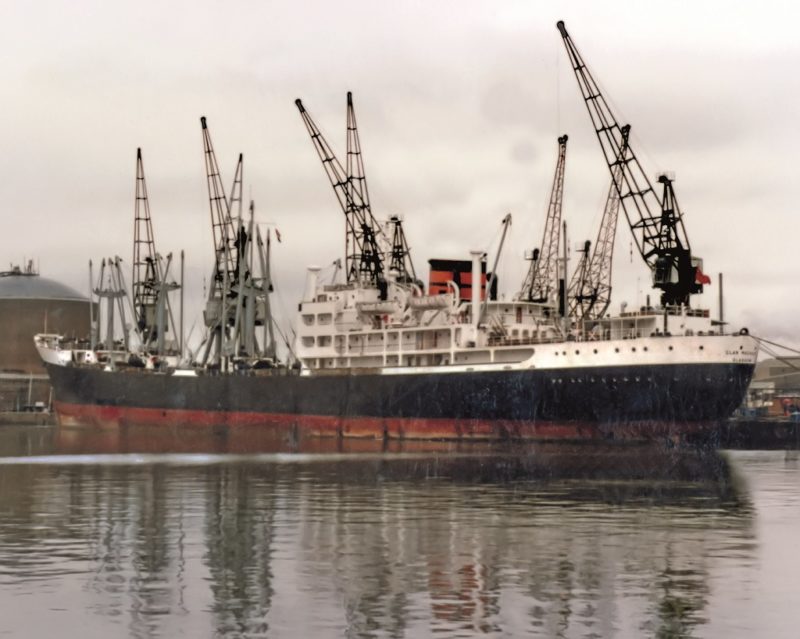
Argyllshire was launched first on 23rd May 1956 at Greenock Dockyard by Countess Jellicoe and sailed on her maiden voyage to Durban on 15th November 1956 under Capt. A.J. Hogg carrying a 103 ton stator for delivery at Melbourne. In 1964, she loaded an exceptionally long 98 ton boiler for Port Elizabeth at Birkenhead. Argyllshire and Ayrshire made a total of 42 voyages of which two dozen loaded homewards from Australia from May 1957 until the Spring of 1965.
The two sisters rarely met in port even though their voyages were on the same routes, but they were widely separated on U.K. sailing dates. The exact sisters were in port together at Tanga for two days in January 1965.
Ayrshire was launched on 19th October 1956 by the Countess of Powis and sailed on her maiden voyage on 25th May 1957 to Australia under the command of Clan Line Commodore Capt. P. Macmillan.
On 23rd March 1965, she ran aground on the south side of the island of Abd al Kuri 430 miles ESE of Aden and near to the island of Socotra to the east and with Cape Guardafui on the tip of the Horn of Africa to the west. There was no loss of life and some 1,400 tons of cargo was off loaded and landed at Aden by barge. This included a 45 ton cracking tower, numerous other heavy lifts, and a large number of expensive cars out of a total manifest of 4,100 tons. After jettisoning almost 3,00 tons of cargo, fuel and water, on 26th April 1965 she was refloated briefly and towed one ship’s length astern, but ran aground again and salvage was abandoned two days later.
A sad end to such a very fine ship was compounded by the fact that Capt. Macmillan was on his retirement voyage. The charts did not show the underwater rock Ayrshire had struck, and later charts were amended to show an area extending almost two miles offshore from the southern tip of Abd al Kuri has underwater rocks rated dangerous to navigation.
Argyllshire subsequently became the Clan Line Commodore flagship and served Clan Line for ten more years. She made the last round voyage to Australia via the Cape of Good Hope in both directions as the Suez Canal was closed.
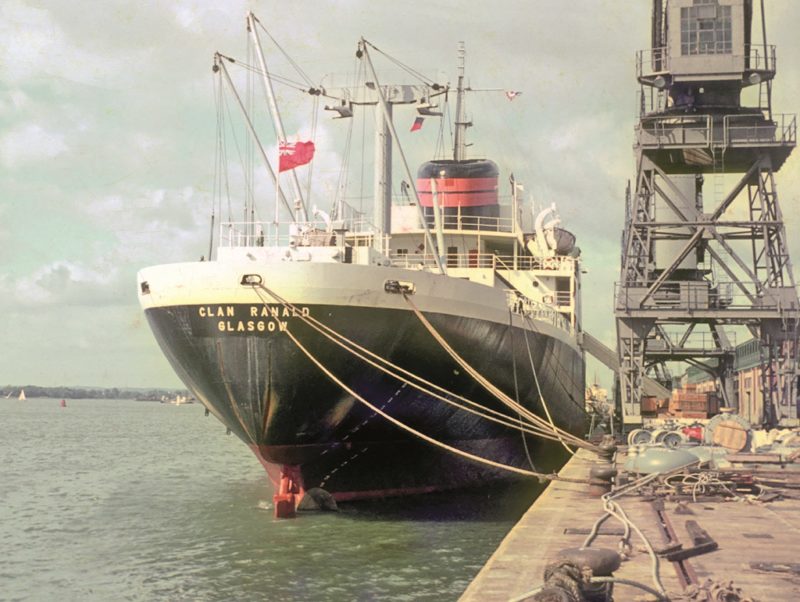
She sailed from Brisbane on 24th January 1970, and from Sydney, Burnie, Melbourne, Adelaide and Fremantle during the next five weeks to terminate the Clan Line and Scottish Shire Line connection with Australia dating back to the 1880s. Argyllshire was sold for further service to Gulf East Marine in 1975 and renamed Schivago, and then on 3rd August 1977 she arrived at Gadani Beach for breaking up.
The steamer Clan Campbell of 1943 left King George V Dock at Glasgow on 22nd June 1955 under the command of Capt. H.C. Simpson for Birkenhead to complete loading on the Clan-Hall-Harrison Line service to East Africa.
She sailed on 30th June and passed the high lighthouse on the cliffs of Cape St. Vincent on 4th July and was near to Gibraltar later that day. They called into Algiers for fuel and water on 6th July and threaded their way through the narrow channel into Port Said on 11th July. After transitting the Suez Canal via the Bitter Lakes they went straight down the Red Sea, omitting calls at Port Sudan, Djibouti and Massawa and encountered no sandstorms to arrive at Aden for more bunkers on 17th July.
They sailed the same day and reached Mombasa on 23rd July to discharge, and Tampa with its beautiful cove on 3rd August, and Dar es Salaam for final discharge on 10th August. However, they were suddenly ordered to sail in ballast to Australia instead of returning home on the Clan-Hall-Harrison Line service.
Clan Campbell rolled all the way to Fremantle for a sixteen day voyage from Dar and arrived on 29th August to take bunkers. She arrived at Port Pirie on a beautiful sunny Sunday morning, 4th September, in company with Clan Macinnes.
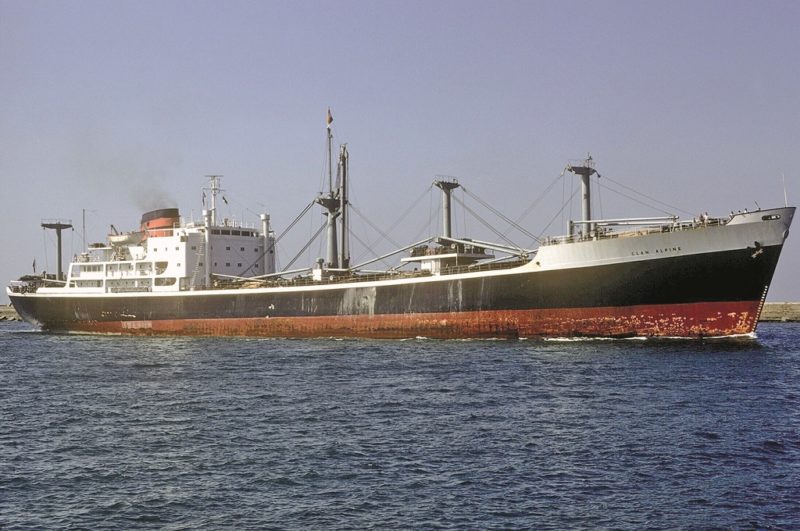
The short haul round to Adelaide was made during the following week to arrive on 11th September to complete the loading of grain and wool. She returned to Fremantle on the return leg on 26th September, where Clan Sinclair was lying on the other side of the harbour, and they left the beautiful Swan river on 28th September, rolling all the way to Cochin to change the Indian crew, calling at Colombo for water.
She took more bunkers at Aden on 15th October before entering the Suez Canal on 20th October to take the north bound convoy, which anchored as usual in the Great Bitter Lake to let the south bound convoy through. She passed Pantellaria with its well terraced and watered vineyards and a large fishing port at the western end, followed by Gibraltar, Ushant and then docked in Dunkirk to discharge on 1st November. The round voyage to East Africa and Australia had taken four months and twelve days when the crew signed off at Hull.
A typical Clan Line voyage to India took three to four months to complete, and would call at either Calcutta or Chittagong on the east coast, or Cochin on the west coast, and Tuticorin on the south west tip of India. Calls at Vizagapatnam on the way south loaded iron ore and tobacco on the winding river berths, Coconada for palmyra fibre and tobacco, Madras for tobacco, ore, leather, crushed bones, magnesite and cotton material, and Pondicherry to load cotton material goods and some heavy cargo. The ports of Trincomalee on the east coast and Galle on the south coast of Ceylon were preferred to the big congested harbour at Colombo on the west coast to load tea and rubber. The Suez Canal and Mediterranean passages were completed to arrive back in the U.K. in three months.
The South African typical voyage by Clan Line would take the same round voyage time of three to four months, with bunkers taken on the south bound voyage at Las Palmas de Gran Canaria, where officers would change from blue uniforms to ‘tropical’ whites. Walvis Bay was the next port of call, followed by Cape Town, Port Elizabeth, East London, Durban and the same ports on the homeward leg.
The Round Africa voyage would instead head north from Durban to Lourenco Marques, Beira, Mtwara, Tanga, Dar es Salaam, Mombasa and then home via Suez, or perhaps a ‘double header’ to the Mediterranean to discharge and then reload for South Africa. This latter voyage was a very long ten month duration voyage,
Internal fighting in Ceylon was nothing new, and Clan Mackinnon built in 1945 was commandeered for a mercy mission there at Colombo in June 1958 after the first flare up of fighting between Tamils and Cingalese. She was requisitioned by the Royal Ceylon Navy after discharging 5,500 tons of general cargo at Colombo, and then embarking 600 Tamil men for transport up the coast to Kankessantuari in the north of the island, taking two days to reach there via the southern coast of Ceylon. Landfall was made at Point Pedro on the third day and after disembarking the Tamils she embarked 67 Cingalese for the return voyage to Colombo, and end her requisition.
The record for the highest number of Clan Line vessels in port together at Beira was nine, this occurred in July 1950 with four alongside at the harbour berths, four at the buoys, or at anchor in the river, and one at the Bar.
Clan Cumming, Clan Chisholm, Clan Forbes, Clan Allan, Clan Macbrayne, Clan Maclean, Clan Macbride, Clan Macbeth and Buteshire were the nine ships.
Seven Clan Line ships were in port at Beira in July 1963 with Clan Maclaren, Clan Mactaggart, Clan Maciver, Clan Finlay, Argyllshire, Stirlingshire, and Kenilworth Castle.
Argyllshire had unloaded a 100 ton transformer and one other vessel was discharging while the remaining five were loading homewards. However, numbers of ships in dock varied as on 1st September 1956 only one Clan Line ship was docked at Beira, but three others had called there before sailing for Australian ports.
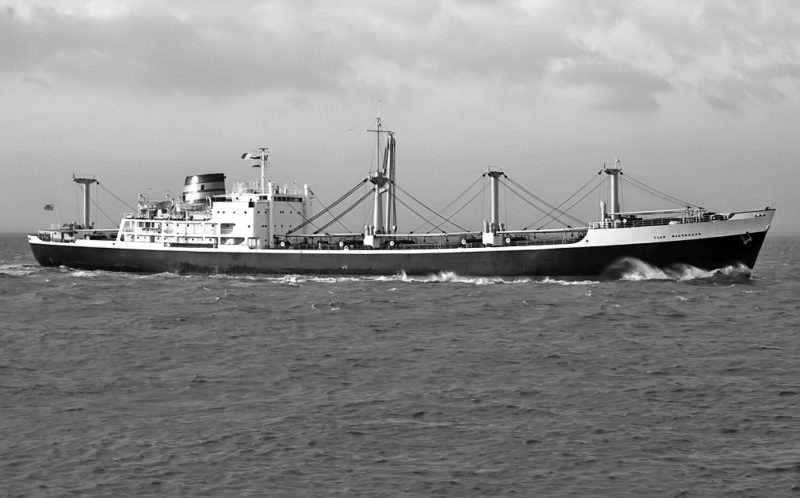
CLAN LINE ‘M’ CLASS of 1957/58, AND FINAL GROUP BUILT TO 1967
The ‘S’ class and its derivatives were the last steamers of Clan Line, and the switch to diesel engines for all subsequent vessels started with the three ‘M’ class sisters Clan Malcolm, Clan Menzies, and Clan Matheson of 1957/58.
Their appearance was similar to the ‘S’ class although without the large funnel ‘helmet’ and a deadweight of 1,000 tons less than the ‘S’ class. The ‘M’ class gave good service until the late 1970s with Clan Malcolm a cadetship in the late 1960s.
A class of sixteen ‘three quarters aft’ class motor vessels were then built between 1958 and 1967, Clan Alpine being the last of the class. They had five holds, four forward and one aft with Clan Maciver as the lead ship in 1958, in between were Clan Macilwraith, Clan Macindoe, Clan Forbes, Clan Fergusson, Clan Fraser, Clan Farquharson, Clan Finlay, Clan Graham, Clan Grant, Clan Macnab, Clan Macnair, Clan Macgillivray, Clan Macgregor, and Clan Macgowan.
The superstructure was usually but not always continued aft to merge with the poop structure. Dimensions of hull and cargo gear varied, gross tonnage varied from 7,300 to 9,025, and deadweight tonnage varied from 10,000 to 12,000.
The engine room was more highly automated so that one engineer officer and an assistant could maintain watch. The five ‘F’ vessels were built at the Tyneside yard of Swan, Hunter & Wigham Richardson Ltd. to provide a monthly service between Liverpool and the Persian Gulf. Two were built by the John Brown yard at Clydebank, with nine of the sixteen from the Greenock Dockyard, which itself was a B. & C. Group yard subsidiary.
Clan Alpine was similar to the Clan Macgregor trio, with only one lifeboat on each side of the superstructure instead of the usual two, and had a larger winch house on the second mast.
Unusual heavy lifts in the 1960s were three giant petroleum reactors loaded in Italy by Clan Macgregor to the Caltex refinery in Milnerton, Cape Town in April 1965, four Australian yachts loaded at Sydney by Clan Macgowan in 1968 and discharged at Dunkirk in time for the annual Cowes Week, heavy transformers and stators weighing over 104 tons taken from Birkenhead by Clan Mactavish, where she loaded them with her own gear, to Port Elizabeth in 1963, and a trawler of length 66 feet stowed athwartships on number 3 hatch of Clan Fergusson and taken to Chittagong in December 1962.
Clan Maclean took the prize for the most unusual heavy lift when two sophisticated British Aircraft Corporation ‘Lightning’ fighters were loaded at Belfast for Aden in May 1961.
Four refrigerated cargo ships were completed in 1965 and 1966 as Clan Ranald, Clan Ramsay, Clan Robertson and Clan Ross of 7,955 grt and 11,730 dwt with a refrigerated capacity of 506,864 cubic feet and powered by seven cylinder B & W diesel engines of 10,350 bhp by J.G. Kincaid & Co. Ltd., Greenock with a high service speed of 18 knots. In 1977, they were renamed Dover Castle, Winchester Castle, Balmoral Castle and Kinpurnie Castle.
The ‘Castle’ suffix became ‘Universal’ in 1979, and they were sold off to Greek owners in 1982 and then broken up in 1984/85.
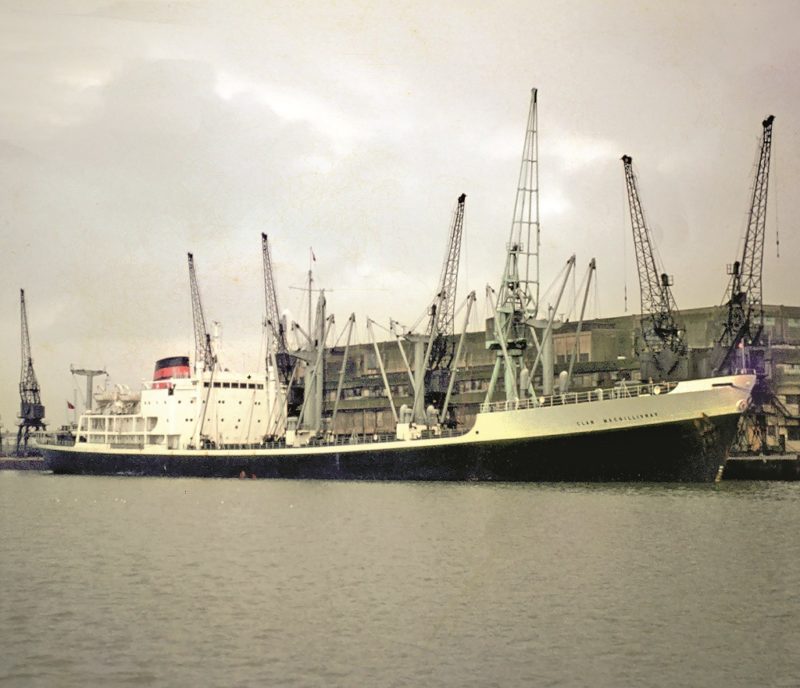
FINALE
A joint East African B. & C./British India Line cargo service began to operate in early June 1969 using Clan Alpine, Clan Macintyre, Clan Grant, Kinnaird Castle, Tantallon Castle, King Charles, King Malcolm, Amra, Bulimba, Chupra, Ozarda, Uganda and chartered tonnage. The rundown of the Clan Line fleet was very rapid after this especially so in the years 1979 to 1981. The container revolution had already started when Clan Alpine was fitting out in early 1967, and management gave a clear indication of their intentions by selecting this name for the last Clan Line ship for it was also the first Clan Line ship in 1878.
Clan Alpine sailed on her maiden voyage from the Tees to South and East Africa on 21st April 1967 under the command of Capt. N.F. Stewart.
The fleet at that time consisted of 41 vessels and the run down of ships on the Indian route started in the early 1970s with the early post war steamers and motor vessels, gathering momentum in the mid-1970s with more departures from the fleet, with only two dozen ships left in 1973 and only 13 ships left in 1979, and these survivors were sold off during the next two years.
The last ten ships were divided equally between the Indian and East African trades, with the port of Nicala in Mozambique figuring prominently in the destination lists.
Clan Macgregor made the final Clan Line voyage by arriving back at Avonmouth on 1st November 1981. She moved round to the Mersey, and departed from there under new owners, but was to last only ten months more in service as she became a total loss on 9th November 1982 due to fire damage when 60 miles south of Cyprus. She was towed to Larnaca and subsequently to Laurium in Greece for breaking up.
Clan Macgillivray had made the last eastbound voyage at about the same time as Clan Macgregor had arrived at Avonmouth. She was immediately sold to Hong Kong owners on arrival back in the U.K. and given a new Clan name, Clan Macboyd, which had never been used in the Clan Line fleet.
Hansa Linie of Bremen provided stiff competition for heavy lift loads from 1950 to 1980, but both great companies gave way to specialist heavy lift jumbo derricks fitted to ships and capable of lifting over two thousand tons when used in tandem. The B. & C. Group shipping interests became B. & C. Group Holdings in 1987 to end their shipping involvement, with the Cayzer family selling their holding for £550 million, but unfortunately B. & C. Holdings collapsed financially in June 1990 some 34 years after the B. & C. Group had been formed in 1956.
The few remaining Clan Line seafarers from the big crews of post-war years still remember with great affection the voyages of their youth.

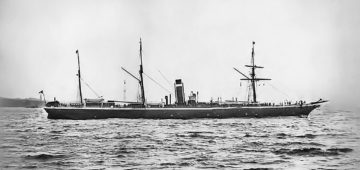



Comments
Sorry, comments are closed for this item